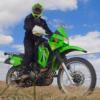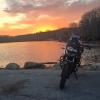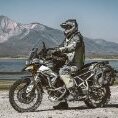Leaderboard
-
in all areas
- All areas
- Events
- Event Comments
- Event Reviews
- Blog Entries
- Blog Comments
- Images
- Image Comments
- Image Reviews
- Albums
- Album Comments
- Album Reviews
- Garage Vehicles
- Garage Vehicle Comments
- Vehicles
- Product Reviews
- Products
- Topics
- Posts
- Articles
- Article Comments
- Article Reviews
- Status Updates
- Status Replies
-
Custom Date
-
All time
December 17 2014 - June 24 2024
-
Year
June 24 2023 - June 24 2024
-
Month
May 24 2024 - June 24 2024
-
Week
June 17 2024 - June 24 2024
-
Today
June 24 2024
-
Custom Date
06/08/2016 - 06/08/2016
-
All time
Popular Content
Showing content with the highest reputation on 06/08/2016 in all areas
-
I can't say my panniers are ultimately better, but made with different philosophy. I would like to explain my ideas behind design and material choice, this probably also helps to understand benefits. First, saying "plastic pannier" is as informative as saying "metal pannier" - imagine 3 similar panniers made from aluminum, steel and lead. Their all metal, but everybody understands that they have very different properties. Same is valid also for plastic. My panniers are made from HDPE (high density polyethylene), while most OEM panniers are made from ABS (acrylonitrile butadiene) - easy to manufacture, stiff and cheap. One important difference between these two materials is elongation at break. When ABS elongation is in 5-25% range, HDPE breaks usually at 100-300% elongation. It means for user, that pannier made from ABS breaks after relatively minor deformation, while you can completely fold HDPE and it still doesn't break - check my crashtest video: https://youtu.be/Bc38U5kVgkA. But main difference between my and other plastic panniers is different philosophy. While other manufacturers have tried to make panniers stiff enough to hold shape (reason to use ABS), I focused to using plastic main advantage over metal - low stiffness and good flexibility - and designed my panniers to benefit from this. And this makes them very different from all others. This also allows me to make my panniers twice as light as common plastic pannier. Biggest disadvantage for OEM panniers is, that most have only 3 point fixing system - 2 upper and third close to passenger footrests, making a triangle. No support for rear lower edge. This means, that even minor crash creates enormous loads to fixing system and while OEM panniers have rather stiff plastic, they break. And finally, making panniers flexible means, that they act like airbags, decreasing dynamic forces and protect your bike. I highsided my KTM 950SE at 80km/h and didn't even bend rear subframe - but right pannier upper corner was deformed after crash. I hope this explains why choose Tark panniers over others2 points
-
I'm thinking this show will just make me want to go out and buy an Africa Twin that much more. My PVR is all set to go. Also watching "RIDE" with Norman Redus.2 points
-
CHINO, CA - June 8, 2016 - (Motor Sports Newswire) - The much anticipated Adventure bike from Honda, the Africa Twin is finally here. Yoshimura is ready for the big red adventure enthusiast with the rock steady RS-4 slip-on . This RS-4, like every slip on we make, is specifically designed for the new Honda to unleash the power, sound and style that can only be Yoshimura. Removing the stock muffler saves over 4 pounds and makes the 988cc parallel twin engine growl! Oval ellipse shaped sleeve Yoshimura's Works Finish for increased durability & adventure friendly design Features an integrated inlet heat shield design for a seamless transition with the stock heat shield The 2016 Honda Africa Twin with the new Street Series RS-4 SS/SS/CF WF slip-on The 2016 Honda Africa Twin with the new Street Series RS-4 SS/SS/CF WF slip-on The Street Series RS-4 SS/SS/CF WF slip-on is a perfect fit on the Africa Twin 2016 Honda Africa Twin Street Series RS-4 pricing Honda Africa Twin 2016 Street RS-4 SO SS/SS/CF WF Part #12400BD520 MSRP:$549.00 Weight savings over stock 4.1 lbs Street Series by Yoshimura - All Street Series systems are Slip-on/Bolt-on applications do not require tampering with the vehicle's emissions control system, yet still deliver that special spirit the world has come to expect from the legendary company known as Yoshimura. Street Series applications cover all of the iconic profiles that Yoshimura has become famous for. From the legendary R-77 mufflers, our R-55 angular masterpieces, and now the new Alpha profile. Our Street Series exhaust offer street-legal options for almost everything on two wheels About Yoshimura R&D of America Yoshimura is "The Leader in Performance" and has been for 60 years. With unmatched skills, knowledge and passion for racing, Yoshimura is on the forefront of the aftermarket. Yoshimura exhaust systems are race bred and feature the same legendary performance, fit, and quality that has been our trademark for six decades. To learn more about Yoshimura and view our wide variety of performance products, visit www.yoshimura-rd.com.1 point
-
Hi, First of all, I apologize for my not really good english, here in Quebec (Canada), the main language is french. My name is Vincent, proud owner of a BMW R1200GS since last year. Motorcyclist since too long (got my license 33 years ago)... I took a 10 years motorcycle break but now I'm back on the saddle. My BMW is equipped mostly for off-road travel (TKC80 tire, crash bars, headlight guard) but, of course, also rides a lot of paved roads.1 point
-
I am glad you enjoyed the ride report! That's a great Idea I'll start working on that sometime tonight or tomorrow morning. You think I should leave the bike packed up as is for the walk around vid?1 point
-
Thanks for the explanation! FYI, you have a reach of 9,332 on FB for this story as I type this1 point
-
I agree, I am signing up with the group in Tucson, where I hope to get more involved. Just hope it is what I am looking for.1 point
-
Premieres Thursday, June 23rd at 8pm HKT, 7pm BKK/JKT Two adventure bikers take on the journey of a lifetime travelling through Morocco, North Africa, on the trail of the ultimate biking challenge, the Dakar Rally. One rider, Christophe Barriere-Varju, has competed in the Dakar Rally four times. The other, Laura Csortan, has never set a wheel off road before. Starting in Marrakech, Morocco, they must make their way through mountains, gorges, rivers and deserts to reach the Moroccan Sahara. Christophe will be sharing his knowledge of what it takes to be an off road adventurer whilst Laura will be pushing her biking skills to the limits and experiencing a journey like never before. Will they make it to their final destination of the Sahara Desert or will the journey of a lifetime be too much for an off road novice?1 point
-
Thank you for sharing your journey with us. When you get home can you do a full walk around of the bike on video and share the story of each scratch and dent.1 point
-
1 point
-
Yeah, me too. Thanks for taking the time to share! Now if Tropical storm Colin would go away, I can go ride!1 point
-
Eric, as you know I've just ended a career in the motorcycle industry. My last position was as Director of Sales and Marketing for Gerbing's, which is the largest selling brand by a substantial margin. And while you would expect that might bias my perspective, read on and see for yourself. To be blunt, there is no "bad" heated gear. Gerbing's, Warm 'N Safe, First Gear, Venture Heat, Powerelet, et al. Essentially, it's just gear with different construction and features, from which you'll have to choose those which suit your needs best. Basically, all heated gear is "wired." That means either Stainless, Copper or Carbon Fiber wires are routed through the product in "heat panels or heat areas," When electricity is shorted through these circuits, the wires heat. The heat panels are not intended primarily just to heat you directly. If they did, you would only get warm where the heat panels are. Instead, it is intended as an undergarment, fitting a little bit on the snug side, but not tightly. Having a little air between you and the garment is important. The heat panels can't help but heat you directly, but more importantly they heat the air that surrounds you, which then heats you more evenly. This is why it is important to use heated gear as an underlayer, beneath a sealed motorcycle jacket, using the thickness of the heated liner to replace the thickness of the jacket's quilted liner, which should be removed. This way, everything fits "normally." The liner creates the heat and the jacket traps the heat. Motorcycle gear that uses Gore-Tex (Aerostich, Klim, etc) is a little bit less effective at holding in the heat because Gore-Tex breathes slightly, and that allows a little bit of cold outside air into the mixture. Usually you just turn up the controller a bit and it compensates for the slight introduction of colder air. Heating elements are generally where much of the controversy and hoopla exist surrounding heated gear. Stainless, Copper or Carbon Fiber. Which is best? Which provides the best heat? Etc. Etc. My opinion is that it doesn't matter. Heat is heat. Warm is warm. Now, having said that, there are different delivery protocols. Again, IMO, multi-strand stainless wire delivers the quickest heat. A simple .025 gauge wire can have up to 200 strands of stainless in it, each about 1/4th the thickness of a human hair. Since heat emanates from the circumferential surface of the wire, multi-strand wires have more circumferential area than solid wires or wires with fewer/larger strands. Thus, multi-strand heating wires heat you more quickly. Note that carbon fiber wires are also small multi-strand wires, and they also heat quickly. Multi-strand wires also respond more rapidly to input from the controller. So when you drop into an ice-cold valley and turn up the heat, it's more immediate. Stainless multi-strand, and to a slightly lesser extent (based on my personal experience) carbon-fiber multi-strand, deliver heat more quickly. Now, we're talking about 10 seconds vs. 30 seconds for copper wire. So you have to decide for yourself if this is important. The wires themselves vary in thickness. Stainless wires are thinnest. However, some manufacturers run Carbon Fiber wiring without its insulation coating, preferring to wrap it in a folded insulating sheet that sticks to itself, kind of like sticking the wires in a thin plastic taco and sealing the edge. Since the purpose of the insulation is to prevent shorting, as long as the wiring patterns are designed to not let the wire cross over itself, it should be fine. Carbon Fiber is actually less expensive by quite a bit than Stainless wrapped in a Teflon-based insulation coating, so expect to pay less for a Carbon Fiber heated liner (and gloves) all else being equal. By that I mean check the other features. A manufacturer may, or may not, have decided to put the savings into other features in the garment. Again, you have to decide what you want in a garment and which of its features are important to you. Wiring circuits within the jackets are also becoming more standardized. Most heated jacket liners are wired with two circuits. One circuit is for the jacket itself (chest, back and sleeves). While the second circuit bypasses the jacket and goes straight to the glove plugs at the end of the sleeves. This way, when using a dual controller, you have one circuit that controls the heat for your torso, and another circuit that controls the heat to your hands. Since your hands are usually out in the air flow, while your torso at least has a little protection from a short windshield (or on a sport-touring bike or a cruiser, often a larger windshield), being able to set the temperature of your torso and your hands independently means much greater comfort. Be aware that the "glove" circuit is usually where the connection point is for heated pants and socks. Therefore, your torso will be on one circuit and all your appendages will be on the other. Makes sense. Like your hands, your legs and feet are also more likely to be "in the wind" and wanting of a heat setting different than that needed for your upper body. Controllers are interesting. A lot of people think of them as rheostats. They're not. Virtually every controller out there is actually a pulse-width modulator. Typically with a PWM controller, the duty cycle is usually about one second. During that second, the controller is set to send power to the wires for a percentage of that second, and then shut itself off for the remainder of that second. So at 50% power, the controller would send power through for half a second and be off for half a second. At 20% power, it would be on for .2 seconds and off for .8 seconds. I think you get the picture. And this happens for every tick of the clock. The duty cycle repeats. I've always been a strong proponent of dual controllers for the reasons in the paragraph above. Having that dual-zone control is just so much easier to be comfortable. More recently, wireless controllers have come onto the market. But wireless isn't completely wireless. The signal from the controller to a receiver in the jacket is wireless, but the power from the motorcycle's electrical system must still be connected to you and the jacket by means of a wire. The advantages of a wireless controller is that there's just one power wire to connect/disconnect as opposed to two circuit wires (from a dual controller to a dual-circuit jacket), and that the wireless feature lets you place the controller pretty much anywhere on your motorcycle. With a wired controller, you need to have the controller attached to your outer jacket, or to something that's close to you when you're in the riding position, such as a tankbag. With a wireless controller, you can position it near the left handgrip for easy access, on your touring bike's dashboard, or anywhere you find it convenient. Amp draw. This is the amount of load that the heated garments pull out of your electrical system. They are rated at full power, such that if I tell you that a Jacket Liner has an amp draw of 70 watts, that's on High. At 50% power, it's on a 50% duty cycle, so the load draw averages 70W x .5 = 35W. At 20% power it would be 70W x .2 = 14W. At 80% power, 70W x .8 = 56W. You need to know the amp draw of your jacket liner, gloves and any other heated garment you're going to be wearing. And also that of any passenger. Then you need to make sure that your motorcycle's alternator can handle the load. A good rule of thumb is to reduce your bike's maximum alternator output by 20% when calculating, just to provide yourself a cushion. Alternators don't make full power all the time. They make more power at more engine rpm, usually up to about 2000 - 2500rpm, by which time they're making full power. So, if you're riding around town at lower rpm, or you have a torquey cruiser that spends some time below max alternator output, reducing the max output by 20% when making calculations gives you a safe cushion. With most BMW's, alternator output is not a problem. Most of the boxers have at least 700W. But what about bikes with lower outputs? Let's take a look at a hypothetical bike with a 400W alternator. First, you have to figure out what it takes to run the motorcycle. For a carbureted bike, figuring ignition system, headlight, taillight, brake light and the occasional turn signal, about 190-200W is about right. For a fuel-injected bike, about 260-275W is about right. Now come the accessories. Got driving lights? About 55W each, or 110W. Very often less if they're HID or LED. Heated grips? 20W (on High). Heated seat? 40W (on High). These are general estimates. So, on a cold day, your fuel-injected bike, with a 400-W alternator (factored down to 320 just to be safe), has about 45-60W to play with. Heated jacket at 50% draws about 35W. Gloves at 50% draw about 15W. You're probably safe. But don't turn on your accessory driving lights, or your draw will exceed the alternator's output and you'll slowly drain your battery. On bikes with questionable alternator limits, it's always a good idea to hook a volt meter up to the battery (Datel makes awesome DVM's). If the battery voltage starts to decline, you can tell and may have to turn some things down, or off, until the voltage builds again. I have this on my V-strom 650. Driving lights plus heated liner, gloves and socks, and I am past my limit. The voltage drains from 14.4V to about 12.5 in 45 minutes. So I have to shut off the extra lights (actually, I added an Eastern Beaver headlight switch and am able to turn off one of the two headlights, saving 55W and barely "balancing" the input/output). Each rider and bike will be different, so you just have to do some basic math and then keep an eye on things the first couple of times you're out in the cold. If it works, you should be OK for the winter. But be careful. Nothing worse than stopping to go to the bathroom and coming out to a bike without enough battery power left to turn over the engine. The bike will still run, IF you can get it started. And in the cold, that's no fun. Anyway, that's a basic summary of things to look for and consider when buying heated gear. As for me, when I'm on my Beemer, I've got all the heat I need. When on the Wee-strom, I'm usually good, but if it's really cold I have to turn off one headlight in order to turn up the heat. As for what I wear, naturally it's Gerbing since when I retired I had a full set of gear and two extra jacket liners and gloves. So I'm set. But I've tested and can recommend just about every major brand. They all keep you warm. It's just a matter of personal preference. However, when it comes to a controller, I do run my gear through a Warm 'n Safe wireless controller for its small size and convenience. But I carry a wired dual controller as a backup just in case. Haven't needed it in 3 years. Hope this helps.1 point






